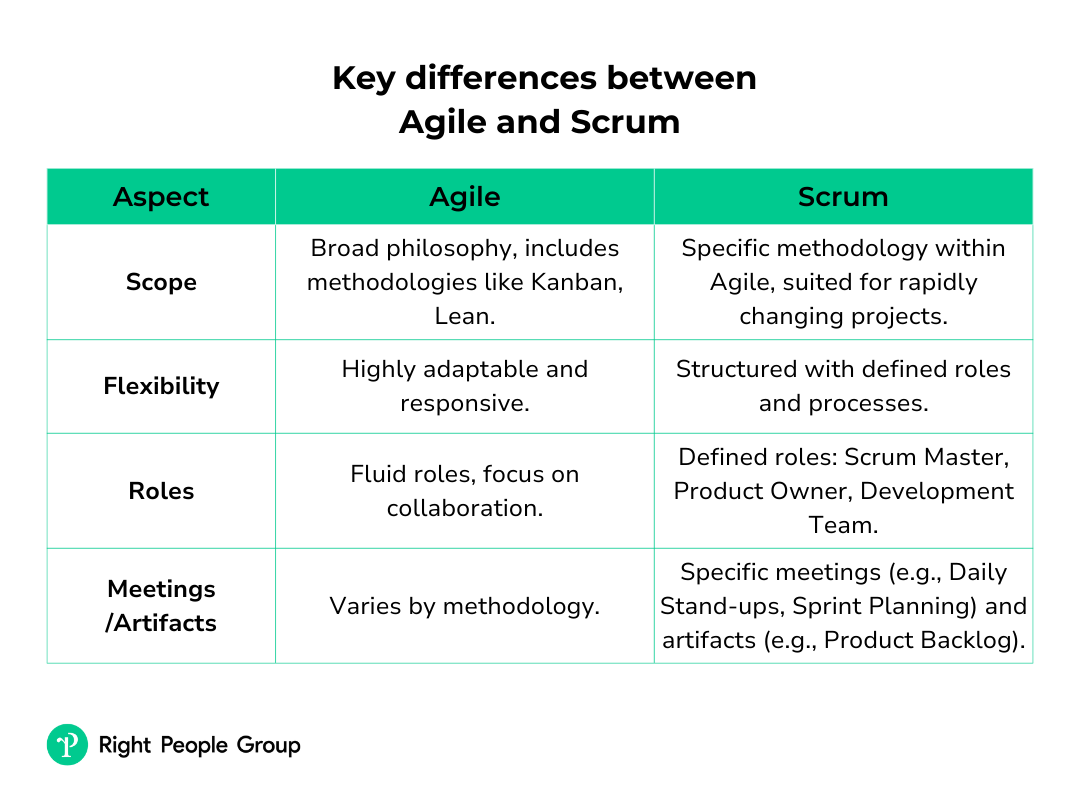Agile and Scrum are key methodologies in project management, particularly in software development. Their popularity lies in their ability to efficiently manage complex projects and adapt to changing needs.
Distinguishing between Agile and Scrum can be challenging, but it’s an important skill for you in building effective teams. Understanding the nuances of each approach is key to ensuring that you hire the right people for your projects.
This article aims to clearly explain Agile and Scrum, focusing on their differences and how they apply in real-world scenarios.
Why understanding the difference matters for hiring managers
As a hiring manager, understanding the distinction between Agile and Scrum is vital for several reasons:
- Building the right team: Knowing whether your organization needs a more structured approach (Scrum) or a more flexible one (Agile) can help in hiring individuals with the right mindset and skills.
- Setting clear expectations: Understanding these methodologies allows you to set clear expectations for roles and responsibilities within the team.
- Aligning with organizational goals: Different projects may require different methodologies. A clear understanding helps in aligning project management approaches with broader organizational goals.
What is Agile?
Agile represents a significant shift in project management and software development, moving away from traditional, rigid methodologies towards a more fluid and responsive approach.
This philosophy, which took shape with the Agile Manifesto in 2001, was a response from software professionals who recognized the need for a more adaptable and customer-centric strategy in software development.
The foundational values of Agile software development are:
- Prioritizing people and interactions: Agile places a strong emphasis on the importance of individuals and their interactions over rigid processes and tools. This focus on human elements fosters a collaborative environment where team dynamics and communication are paramount.
- Emphasizing working software: The goal of delivering functional software takes precedence over creating extensive documentation. This value reflects Agile’s commitment to providing tangible, usable results at every stage of development, ensuring that progress is measurable and relevant to customer needs.
- Valuing customer collaboration: Agile encourages ongoing collaboration with customers rather than relying solely on initial contract negotiations. This continuous engagement allows for feedback and adjustments, aligning the development process more closely with customer expectations and requirements.
- Adapting to change: In Agile, the ability to respond to change is more important than strictly adhering to a predefined plan. This adaptability allows teams to pivot and make necessary adjustments, ensuring the end product remains relevant and valuable in a dynamic market.
The 12 key Agile principles
The Agile methodology is underpinned by 12 principles that reinforce its core values, with several specifically emphasizing the concept of iteration. These principles create a framework that guides teams in implementing Agile effectively:
- Customer satisfaction through early and continuous delivery: Agile prioritizes ensuring customer satisfaction by consistently and promptly delivering value throughout the project.
- Welcoming changing requirements: Teams are encouraged to accommodate changes in requirements, even late in the development process, to enhance the product’s value.
- Frequent delivery of working software: The frequent delivery of functional software is key, with a preference for shorter timescales.
- Collaboration between business stakeholders and developers: Regular and close collaboration between the business side and developers is essential for aligning the product with business needs and customer expectations.
- Supportive, trusting, and motivated environment: Agile promotes an environment where team members are supported and trusted, which is important for their motivation and effectiveness.
- Face-to-face conversation as the best form of communication: Direct, face-to-face communication is encouraged to ensure clarity and understanding.
- Working software as the primary measure of progress: The main indicator of progress in Agile is the delivery of functional software.
- Sustainable development pace: Agile aims for a sustainable pace of development that can be maintained indefinitely.
- Continuous attention to technical excellence and good design: Ongoing focus on technical excellence and good design enhances agility.
- Simplicity: Maximizing the amount of work not done is essential, focusing on simplicity and efficiency.
- Self-organizing teams: Agile relies on self-organizing teams that are best positioned to deliver high-quality results.
- Regular review and change: Teams often look at their work to find ways to improve and make the needed changes in how they do things.
These principles collectively ensure that Agile is not just a set of rules or procedures but a mindset that encourages flexibility, responsiveness, and a relentless focus on delivering value.
Understanding and embracing these principles is key for any team or organization aiming to implement Agile methodologies effectively.
Hire an Agile consultant who has experience in your industry. Contact us and get shortlisted candidates for free.
Scrum: A detailed look at agile in practice
Scrum stands as a distinct and structured subset within the agile framework, designed specifically for facilitating agile development. This method transforms the agile mindset into a tangible and systematic process. Here’s a closer look at the key components that define scrum:
Sprints: the heartbeat of scrum
Sprints are the core of the scrum process, typically lasting 2-4 weeks. During a sprint, the team focuses on a predetermined set of tasks to produce a reviewable and potentially deliverable segment of the project. These short, consistent cycles enable teams to break down complex projects into manageable chunks, allowing for regular assessment and adaptation.
Defining roles in a scrum team
In scrum, clarity of roles is paramount. The three primary scrum roles are:
- Product owner: This person is the voice of the customer within the team, responsible for defining the project goals, prioritizing the backlog, and ensuring the team delivers value to the business.
- Scrum master: Acting as a facilitator and coach, the scrum master supports the team in following the scrum process, helps remove obstacles, and ensures effective communication.
- Development team: A group of professionals who do the work of delivering the product. They are self-organizing, cross-functional, and responsible for producing the project’s deliverables.
Related reading: Product manager vs product owner: Who to hire for your business?
Scrum events: structuring team interaction
Scrum structures team interactions through four main events, each serving a specific purpose:
- Sprint planning: This meeting sets the stage for the sprint. The team selects work from the backlog and plans the sprint.
- Daily stand-ups: These brief, daily meetings keep the team aligned, informed about progress, and aware of any impediments.
- Sprint reviews: At the end of each sprint, this event allows the team to demonstrate what they’ve completed and gather feedback to adjust the next steps.
- Sprint retrospectives: This is a reflection meeting where the team discusses what went well, what could be improved, and how to make the next sprint more effective.
Scrum artifacts: tools for transparency and adaptation
Scrum employs three primary artifacts to manage and track the progress of work:
- Product backlog: This is a dynamic list of everything that might be needed in the product, prioritized by the product owner.
- Sprint backlog: A subset of the product backlog, this contains items selected for the current sprint, plus a plan for delivering them.
- Increment: The version of the product from the current sprint, which must be in a usable condition and meet the scrum team’s definition of “done”.
The scrum process: a cycle of continuous improvement
The scrum process is a loop of continuous improvement. Each sprint begins with planning, progresses through daily work and collaboration, and concludes with a review and retrospective. This cycle allows the team to adapt to changes quickly, learn from their experiences, and continuously improve their work process. The aim is to deliver a segment of the product that is ready for use at the end of each sprint, ensuring steady progress towards the project’s overall goals.
In summary, scrum provides a structured yet flexible framework that empowers teams to work efficiently, adapt to changing requirements, and deliver tangible results regularly. For organizations looking to implement agile methodologies, scrum offers a clear and proven path to achieving those objectives.
For a quick overview of how scrum works, watch this video:
Hire a Scrum consultant who knows what to do in projects lie yours. Contact us and get screened candidates for free.
Differences between Agile and Scrum
Agile and Scrum are two methodologies often discussed in the realm of project management, especially in software development. While they share common principles, their applications and approaches have distinct characteristics.

Scope and application
Agile represents a broad philosophy in project management. It’s an umbrella term that includes a variety of methodologies such as Scrum, Kanban, and Lean. Each of these methodologies under the Agile umbrella has unique practices and principles, but they all share the common goal of enabling teams to work more efficiently and respond more effectively to change.
Scrum, on the other hand, is a specific methodology within the Agile framework. It provides a structured yet flexible way of managing projects. Scrum is particularly well-suited for projects with rapidly changing or highly emergent requirements. It breaks down complex tasks into smaller, manageable segments, allowing teams to focus on delivering specific features in short cycles known as Sprints.
Flexibility versus structure
The Agile philosophy is centered around adaptability and responsiveness. It encourages teams to be flexible and to adapt their processes as projects evolve. Agile focuses on principles and values that guide teams towards effective collaboration and decision-making.
In contrast, Scrum provides a more structured approach. It comes with a set of defined roles, events, and artifacts that create a framework for the team to operate within. This structure helps teams to maintain focus and discipline, ensuring that they can manage their work effectively without losing sight of the end goal.
Roles and responsibilities
In Agile, roles and responsibilities are fluid. Teams are encouraged to collaborate and share responsibilities, with a focus on delivering results rather than adhering to strict job titles or roles.
Scrum, however, has clearly defined roles. The Scrum Master facilitates the process, ensuring that the team adheres to Scrum practices and resolves any obstacles that may impede their progress. The Product Owner manages the product backlog and ensures that the team is working on tasks that deliver the most value. The Development Team is responsible for executing the tasks and delivering the product increments.
Meetings and artifacts
Scrum is known for its specific meetings and artifacts, which are not necessarily a part of other Agile methodologies. Key Scrum events include Daily Stand-ups, Sprint Planning, Sprint Review, and Sprint Retrospective. These meetings help the team stay aligned, discuss progress, and plan for upcoming tasks.
The artifacts in Scrum, such as the Product Backlog and Sprint Backlog, are tools that help in organizing and prioritizing work. The Product Backlog is a list of all desired work on the project, while the Sprint Backlog contains items selected for the current Sprint, along with a plan for delivering them.
Agile and scrum in project management
Both Agile and Scrum methodologies offer significant benefits in project management. Agile project management is adaptable and responsive, focusing on delivering value and accommodating changes quickly. It suits projects where customer needs are continuously evolving.
Scrum project management provides a clear, structured approach within the Agile framework, making it ideal for managing complex projects, particularly in software development. It helps teams to break down large projects into manageable tasks, delivering tangible results at the end of each Sprint.
Emphasis on cross-functional teams
A key aspect of both Agile and Scrum is the emphasis on cross-functional teams.
Agile teams often take on various roles and responsibilities, collaborating closely to deliver high-quality results. This approach encourages a high degree of flexibility and creativity within the Agile team.
In Scrum, the cross-functional nature is structured around specific roles. This structure ensures that each aspect of the project is given due attention, and responsibilities are clearly defined. The collaboration in Scrum teams is focused on achieving the goals set for each Sprint, leading to efficient and effective project completion.
Implementing scrum and agile in your organization
Successful implementation of Agile and Scrum methodologies in your organization involves several key steps. Here’s a detailed guide to help you navigate this transition smoothly:
Comprehensive training and education
- Structured learning programs: Develop a structured training program for your team. This should cover the fundamentals of Agile principles and the specific mechanics of the Scrum framework. Ensure that the training is interactive and includes real-world scenarios to help your team relate to and understand the concepts better.
- Role-specific training: Tailor training sessions for different roles. For instance, Scrum Masters and Product Owners may need more in-depth training compared to other team members. This ensures that each team member is well-equipped to fulfill their specific responsibilities.
- Ongoing learning opportunities: Encourage continuous learning by providing access to workshops, seminars, and online courses. This helps your team stay updated with the latest trends and practices in Agile and Scrum.
Facilitate a cultural shift
- Leadership involvement: Ensure that the transition to Agile and Scrum has strong support from leadership. Leaders should actively promote the values of flexibility, collaboration, and responsiveness. Their involvement can significantly influence the team’s willingness to embrace the new methodologies.
- Promoting open communication: Create an environment where open communication is encouraged. Regular meetings where team members can share ideas, challenges, and feedback can foster a culture of transparency and collaboration.
- Encouraging team autonomy: Empower your teams by giving them the autonomy to make decisions related to their work. This can boost their confidence and commitment to the Agile and Scrum methodologies.
Emphasize continuous improvement
- Regular retrospectives: Implement regular retrospective meetings at the end of each sprint. Use these meetings to discuss what went well, what didn’t, and how processes can be improved. This practice helps in identifying and addressing issues promptly.
- Feedback mechanisms: Establish clear channels for feedback. Encourage team members to provide constructive feedback on processes and practices. This can help in making necessary adjustments and improvements.
- Measuring progress: Use metrics and KPIs to measure the effectiveness of Agile and Scrum practices in your organization. This data can help you understand the impact of these methodologies on productivity and quality of work.
Conclusion
Agile and Scrum, while often used interchangeably, are distinct concepts. Agile is a broad philosophy emphasizing adaptability and customer-centric development, while Scrum is a specific framework within Agile, providing structured roles, events, and artifacts. As a hiring manager, understanding these differences is important for building effective teams and aligning project management methodologies with your organization’s goals.
The choice between Agile and Scrum should be based on your project’s specific needs, your team’s dynamics, and your organizational culture. Both approaches, when implemented correctly, can lead to increased efficiency, better product quality, and higher customer satisfaction.













